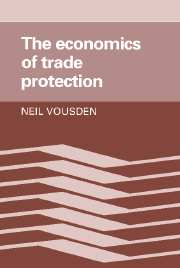Book contents
7 - Monopolistic competition and product differentiation
Published online by Cambridge University Press: 18 December 2009
Summary
In this chapter, we explore the effects of trade restrictions in industries producing differentiated products. Such industries are not, in general, characterized by perfect competition, particularly if there are economies of scale, but, unless fixed costs are very high, we usually expect more than one producer, probably a large number of producers in the industry. The most suitable model appears to be one in which there is a large number of firms in the industry, each possessing some market power with respect to its own product (which is imperfectly substitutable for those produced by other firms in the industry), but not perceiving any strategic interaction between itself and its competitors. Presumably, the industry would also be characterized by free entry–exit of firms with long-run zero profits. This type of market structure, termed monopolistic competition, combines some elements of perfect competition (no strategic interactions between firms, free entry) with some elements of the oligopoly models of the previous chapter. Monopolistic competition differs from oligopoly precisely because the number of firms is large enough for strategic interactions among them to be negligible.
Allowing explicitly for product differentiation serves to emphasize some aspects of protection policy which we have previously ignored. In particular, consumers may derive additional benefits from product variety; consumer welfare is affected to the extent that trade restrictions change the number of product varieties available. In addition, in industries producing differentiated products, intra-industry trade (previously encountered in the Brander and Krugman model of Chapter 6) assumes greater importance, with trading economies simultaneously importing some product-differentiates and exporting others in the same industry.
- Type
- Chapter
- Information
- The Economics of Trade Protection , pp. 151 - 174Publisher: Cambridge University PressPrint publication year: 1990

